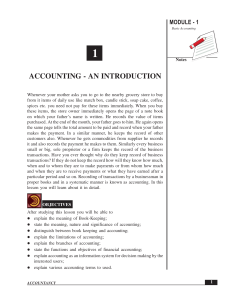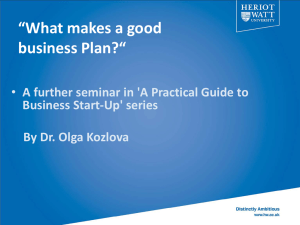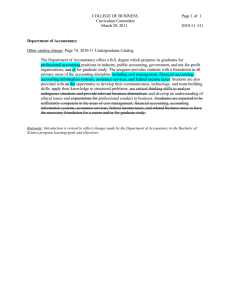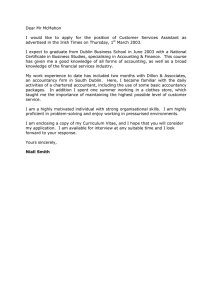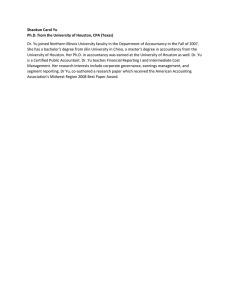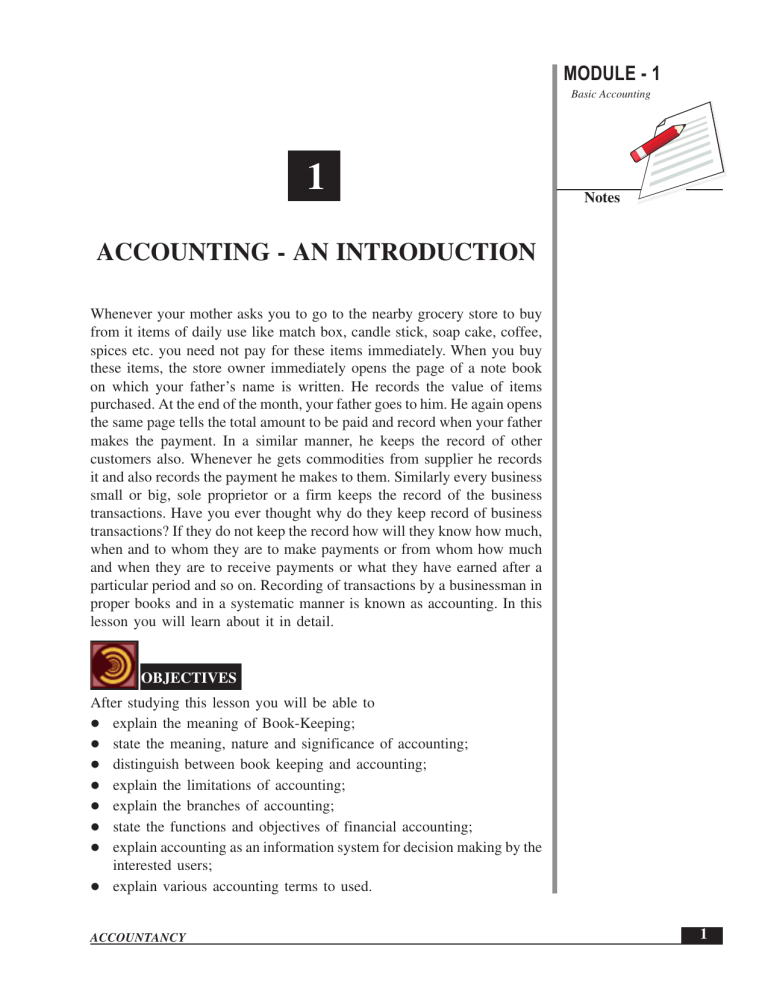
MODULE - 1 Accounting - An Introduction Basic Accounting 1 Notes ACCOUNTING - AN INTRODUCTION Whenever your mother asks you to go to the nearby grocery store to buy from it items of daily use like match box, candle stick, soap cake, coffee, spices etc. you need not pay for these items immediately. When you buy these items, the store owner immediately opens the page of a note book on which your father’s name is written. He records the value of items purchased. At the end of the month, your father goes to him. He again opens the same page tells the total amount to be paid and record when your father makes the payment. In a similar manner, he keeps the record of other customers also. Whenever he gets commodities from supplier he records it and also records the payment he makes to them. Similarly every business small or big, sole proprietor or a firm keeps the record of the business transactions. Have you ever thought why do they keep record of business transactions? If they do not keep the record how will they know how much, when and to whom they are to make payments or from whom how much and when they are to receive payments or what they have earned after a particular period and so on. Recording of transactions by a businessman in proper books and in a systematic manner is known as accounting. In this lesson you will learn about it in detail. OBJECTIVES After studying this lesson you will be able to l explain the meaning of Book-Keeping; l state the meaning, nature and significance of accounting; l distinguish between book keeping and accounting; l explain the limitations of accounting; l explain the branches of accounting; l state the functions and objectives of financial accounting; l explain accounting as an information system for decision making by the interested users; l explain various accounting terms to used. ACCOUNTANCY 1 MODULE - 1 Accounting - An Introduction Basic Accounting 1.1 BOOK KEEPING AND ACCOUNTING Notes A business undertakes number of transactions. Can you estimate the number of transactions a business undertakes? It depends upon the size of a business entity. Every day business transactions may be around hundreds/thousands. Can a businessman remember all these transactions in every respect? Not at all. So it becomes necessary to record these business transactions in details and in a systematic manner. Recording of business transactions in a systematic manner in the books of account is called book-keeping. BookKeeping is concerned with recording of financial data. This may be defined as. “The art of keeping a permanent record of business transactions is book keeping”. From book keeping important details such as total sales, total purchases, total cash receipts, total payments, etc. may be ascertained. As you know the main objective of business is to earn profits. In order to achieve this objective, mere recording of business transactions is not enough. Accounting involves not only book keeping but also many other activities. In 1941, the American Institute of Certified Public Accountants (AICPA) defined as “The art of recording, classifying, summarising, analysing and interpreting the business transactions systematically and communicating business results to interested users is accounting” Accounting is identified with a system of recording of business transactions that creates economic information about business enterprises to facilitate decision making. The function of accounting is to provide quantitative information, primarily financial in nature, about economic entities, that is intended to be useful in making economic decisions. The American Accounting Association defined accounting as : “It is the process of identifying, measuring, recording and communicating the required information relating to the economic events of an organisation to the interested users of such information. In order to appreciate the nature of accounting it is necessary to understand the following relevant aspects of the definition of accounting: l 2 Economic events : It is the occurring of the consequence to a business organisation which consists of transactions that are measurable in monetary terms. Purchase of a Machinery, installing and keeping it ready for manufacturing is an economic event which consists of a number of financial transactions. These transactions are (a) buying the machine, (b) transporting the same, (c) preparing the site for its installation and (d) incurring expenditure on installing the same. ACCOUNTANCY Accounting - An Introduction MODULE - 1 Basic Accounting Identification, Measurement, Recording and Communication : Identification implies determining what transactions are to be recorded i.e. items of financial character are to be recorded. For example, goods purchased for cash or on credit will be recorded. Items of non-financial character such as changes in managerial policies, etc. are not recorded in the books of accounts. Measurement means quantification of business transactions into financial terms by using monetary unit. If an event cannot be quantified in monetary terms, it is not considered fit for recording in the books of the firm. That is why important items like appointment, signing of contracts, etc. are not shown in the books of accounts. Recording : Having identified and measured the economic events in financial terms, these are recorded in the books of accounts in monetary terms and date wise. The recording of the business transactions is done in such a manner that the necessary financial information is summarized as per well established accounting practice. Communication : The economic events are identified, measured and recorded in such a manner that the necessary relevant information is generated and communicated in a certain form to the management and other internal and external users of information. The financial information is regularly communicated through accounting reports. l Organisation : refers to a business enterprise whether for profit or not for profit motive. l Interested users of information. Many users need financial information to make important decisions. These users can be investors, creditors, labour unions, Trade Associations, etc. Evolution of Accounting Evolution of Accounting as per Indian mythology Chitra Gupta is responsible for maintaining accounts in God’s court. A book on Arthashasthra written by Kautilya who was a minister in Chandra Gupta’s kingdom twenty three centuries ago mentions about the accounting practices in India. It describes how accounting records have to be maintained. In China and in Egypt accounting was used for maintaining revenue records of the government treasury. A book on Arithmetica Geometrica, Proportion at Proportionality (Review of Arithmetic and Geometric proportion) by an Italian Luca Pacioli is considered as the first authentic book on double entry book keeping. In his book he used the present day popular terms of accounting Debit (Dr.) and Credit (Cr). He also discussed the details of memorandum, journal, ledger and specialised accounting procedures. He also stated that, “all entries have to be double entries, i.e. if you make one creditor you must make some debtor. l ACCOUNTANCY Notes 3 MODULE - 1 Accounting - An Introduction Basic Accounting Accounting process can be summarised as Notes Fig.1.1 Accounting Process Difference between book keeping and accounting : Book keeping and accounting can be differentiated on the basis of nature, objective, function, basis, level of knowledge, etc. Table 1.1 Difference between Book Keeping and Accounting Basis of Difference 4 Book-keeping Accounting Nature It is concerned with identifying financial transactions; measuring them in monetary terms; recording and classifying them. It is concerned with summarizing the recorded transactions, interpreting them and communicating the results. Objective It is to maintain systematic records of financial transactions. It aims at ascertaining business income and financial position by maintaining records of business transactions. Function It is to record business transactions. So its scope is limited. It is the recoding, classifying, summarizing, interpreting business transactions and communicating the results. Thus its scope is quite wide. Basis Vouchers and other supporting documents are necessary as evidence to record the business transactions. Book-keeping works as the basis for accounting information. Level of Knowledge It is enough to have elementary knowledge of accounting to do bookkeeping. For accounting, advanced and indepth knowledge and understanding is required. Relation Book-keeping is the first step to accounting. Accounting begins where bookkeeping ends. ACCOUNTANCY MODULE - 1 Accounting - An Introduction Basic Accounting INTEXT QUESTIONS 1.1 I. Fill in the blanks with suitable word/words: 1. Keeping systematic record of business transactions is known as ................................... Notes 2. The next step after classification of recorded transactions is ................................... 3. The whole process of recording, classifying, summarizing and interpreting the business transactions systematically and communicating business results to the interested users of financial information is known as ................................... 4. Interested users of accounting information are ................................ II. Identify transactions related to book-Keeping or accounting and write B for book-keeping and A for accounting against the space provided: 1. Credit Sales/Purchases (................) 2. Cash Purchases/Sales (................) 3. Calculation of business profits (................) 4. Find out total debtors (................) 5. Find out financial position of the business enterprise (................) 1.2 BRANCHES AND OBJECTIVES OF ACCOUNTING Branches of accounting The changing requirements of the business over the centuries have given rise to specialized branches of accounting and these are : Financial accounting It is concerned with recording the transactions of financial character, summarising and interpreting them and communicating the results to the users. It ascertains profit earned or loss incurred during a period (usually one year as accounting year) and the financial position as on the date when the accounting period ends. It can provide financial information required by the management and other parties. The word accounting and financial accounting are used interchangeably. At present we are concerned with financial accounting only. ACCOUNTANCY 5 MODULE - 1 Accounting - An Introduction Basic Accounting Cost accounting Notes It analyses the expenditure so as to ascertain the cost of various products manufactured by the firm and fix the prices. It also helps in controlling the costs and providing necessary costing information to management for decision making. Management accounting It is concerned with generating information relating to funds, cost and profits etc. This enables the management in decision making. Basically, it is meant to assist the management in taking rational policy decisions and to evaluate the impact of its decisions and actions and the performance of various departments.. Tax accounting This branch of accounting has grown in response to the difficult tax laws such as relating to income tax, sales tax etc. An accountant is required to be fully aware of various tax legislations. Social accounting This branch of accounting is also known as social reporting or social responsibility accounting. It discloses the social benefits created and the costs incurred by the enterprise. Social benefits include such facilities as medical, housing, education, canteen, provident fund and so on while the social costs may include such matters as exploitation of employees, industrial interest, environment pollution, unreasonable terminations, social evils resulting from setting up industries etc. Human resource accounting It is concerned with human resource of an enterprise. Accounting methods are applied to evaluate the human resources in money terms. It is, therefore, an accounting for the people of the organisation. National resource accounting It means the accounting for the resources of the nation as a whole such as water resources, mining, forests etc. It is generally not concerned with the accounting of individual business entities and is not based on generally accepted accounting principles. It has been developed by the economists. You will study about financial accounting in details. 6 ACCOUNTANCY Accounting - An Introduction MODULE - 1 Basic Accounting Objectives and Functions of financial accounting The main objectives of financial accounting are as under : Finding out various balances Systematic recording of business transactions provides vital information about various balances like cash balance, bank balance, etc. Notes Providing knowledge of transactions Systematic maintenance of books provides the details of every transactions. Ascertaining net profit or loss Summarisation in form of Profit and Loss Account provides business income over a period of time. Depicting financial position Balance sheet is prepared to depict financial position of business means what the business owns and what owes to others. Information to all interested users After analysis and interpretation, business performance and position are communicated to the interested users. Fulfilling legal obligations Vital accounting information helps in fulfilling legal obligations e.g. sales tax, income tax etc. Functions of accounting The function of accounting is to provide quantitative information primarily financial in nature about economic entities, which is intended to be useful in making economic decisions. Financial accounting performs the following major functions: Maintaining systematic records Business transactions are properly recorded, classified under appropriate accounts and summarized into financial statements. Communicating the financial results It is used to communicate financial information in respect of net profits (or loss), assets, liabilities etc. to the interested parties. Meeting Legal Requirements The provisions of various Laws such as Companies Act, 1956 Income Tax and Sales/VAT Tax Acts, require the submission of various statements i.e. Annual accounts, Income Tax returns, Returns for VAT etc. ACCOUNTANCY 7 MODULE - 1 Accounting - An Introduction Basic Accounting Fixing responsibility It helps in computation of profits of different departments of an enterprise. This facilitates the fixing of the responsibility of departmental heads. Decision making Notes It provides the users the relevant data to enable them make appropriate decisions in respect of investment in the capital of the business enterprise or to supply goods on credit or lend money etc. Limitations of Accounting 1. Accounting information is expressed in terms of Money : Nonmonetary events or transactions are completely omitted. 2. Fixed assets are recorded in the accounting records at the original cost : Actual amount spent on the assets like building, machinery, plus all incidental charges is recorded. In this way the effect of rise in prices not taken into consideration. As a result the Balance Sheet does not represent the true financial position of the business. 3. Accounting information is sometimes based on estimates: Estimates are often inaccurate. For example, it is not possible to predict the actual life of an asset for the purpose of depreciation. 4. Accounting information cannot be used as the only test of managerial performance on the basis of mere profits : Profit for a period of one year can readily be manipulated by omitting certain expenses such as advertisement, research and development, depreciation etc. i.e. window dressing is possible. 5. Accounting information is not neutral or unbiased : Accountants ascertain income as excess of revenue over expenses. But they consider selected revenue and expenses for calculating profit of the concern. They also do not include cost of such items as water, noise or air pollution i.e. social cost they may use different methods of valuation of stock or depreciations. INTEXT QUESTIONS 1.2 I. Following are the statements relating to various branches of accounting. Write against each branch of accounting. 1. It analyses the expenditure so as to ascertain the cost of products manufactured by the concern. 8 ACCOUNTANCY Accounting - An Introduction MODULE - 1 Basic Accounting 2. Accounting that discloses the social benefits and the costs incurred by the business enterprises. 3. Accounting for the resources of the water as a whole. 4. Accounting that is concerned with generating information that will enable the management in decision making. Notes II. Write against each statement which explains how it is a limitation of accounting. 1. Fixed assets are recorded in the accounting records at the original cost. 2. Accounting information is sometimes based on estimates 3. Accounting information cannot be used as the only test of managerial performance on the basis of mere profit 4. Accounting information is expressed in terms of money 1.3 ACCOUNTING AS AN INFORMATION SYSTEM AND ACCOUNTING TERMS In 1970, the Accounting Principles Board of The American Institute of certified Public Accountants (AICPA) emphasized that the function of accounting is to provide quantitative information, primarily financial in nature, about economic entities, that is intended to be useful in making economic decisions. Accounting is often called the “Language of Business”. It is the common language used to communicate financial information to individuals, organisations, government agencies about various aspects of business such as financial position, operating results (i.e. Profit or loss) and cash flows. Users, both inside and outside the business, have to make decisions concerning the allocation of limited economic resources. In order to ensure that resources are allocated in an efficient and effective manner, users require financial information for the purpose of making decisions. Accounting provides information that is useful in making business and economic decisions. It is the primary means of communicating financial information to owners, lenders, managers,. Government and its regulatory agencies ‘-and -others- who have interest in an enterprise. It helps the users in taking better decisions by providing relevant, reliable and timely information on the financial and operational position of an enterprise. It is observed that almost all business enterprises maintain detailed accounting records. Even the most intelligent manager with a sharp memory would find it difficult to remember the daily transactions simply by ACCOUNTANCY 9 MODULE - 1 Accounting - An Introduction Basic Accounting observing them. So he/she must rely upon the accounting process which begins with the recording of business transactions and ends up with the preparation of summarized financial statements. Thus, Accounting as an information system is necessitated by great complexity of modern business organisations. Notes Accounting terms Business Entity Business entity means a specific identifiable business enterprise like Big bazaar, Super Bazaar, Your father’s shop, Transport limited, etc. An accounting system is always devised for specific business entity (may be called an accounting entity). For accounting, it is assumed that business has separate existence and its entity is different from that of its owner(s). Every transaction is analysed from the point of view of a business enterprise and not that of the person(s) who are associated with it. For example, when the owner of the business introduces cash in the business, accounting records show that business has more cash although it does not affect the overall cash (personal plus business) position of the owner. At the same time, business enterprise records that an equivalent amount is payable by the business enterprise to the owner of the business i.e. capital. Transaction It is an event which involves exchange of some value between two or more entities. It can be purchase of stationery, receipt of money, payment to a supplier, incurring expenses, etc. It can be a cash transaction or a credit transaction. Purchases This term is used for goods to be dealt-in i.e. goods are purchased for resale or for producing the finished products which are meant for sale. Goods purchased may be Cash Purchases or Credit Purchases. Thus, Purchase of goods is the sum of cash purchases and credit purchases. Sundry creditors Creditors are persons who have to be paid by an enterprise an amount for providing goods and services on credit. Sales Sales are total revenues from goods or services provided to customers. Sales may be in cash or in credit. 10 ACCOUNTANCY Accounting - An Introduction MODULE - 1 Basic Accounting Sundry debtors Persons who are to pay for goods sold or services rendered or in respect of contractual obligations. It is also termed as debtor, trade debtor, and accounts receivable. Revenue (Sales) Notes Sales revenue is the amount by selling its products or providing services to customers. Other items of revenue common to many businesses are: Commission, Interest, Dividends, Royalties, and Rent received, etc. Revenue is also called Income. Expenses Costs incurred by a business in the process of earning revenue are called expenses. In general, expenses are measured by the cost of assets consumed or services used during the accounting period. The common items of expenses are: Depreciation, Rent, Wages, Salaries, Interest, Cost of Heating, Light and water and Telephone, etc. Income The difference between revenue and expense is called income. For example, goods costing Rs.25000 are sold for Rs.35000, the cost of goods sold, i.e. Rs.25000 is expense, the sale of goods, i.e. Rs.35000 is revenue and the difference. i.e. Rs.10000 is income. In other words, we can state that income = Revenue - Expense. Gain Usually this term is used for profit of an irregular nature, for example, capital gain. Loss It means something against which the firm receives no benefit. It is a fact that expenses lead to revenue but losses do not, such as theft. Profit It is the excess of revenue of a business over its costs. It may be gross profit and net profit. Gross profit is the difference between sales revenue or the proceeds of goods sold and/or services provided over its direct cost of the goods sold. Net profit is the profit made after allowing for all types of expenses. There may be a net loss if the-expenses exceed the revenue. ACCOUNTANCY 11 MODULE - 1 Accounting - An Introduction Basic Accounting Expenditure Notes Spending money or incurring a liability for some benefit, service or property received is called expenditure. Payment of rent, salary, purchase of goods, purchase of machinery, etc. are some examples of expenditure. If the benefit of expenditure is exhausted within a year, it is treated as revenue expenditure. In case the benefit of expenditure lasts for more than one year, it is treated as an asset also known as capital expenditure. Expenditure is usually the amount spent for the purchase of assets. It increases the profit earning capacity of the business. Expense, on the other hand, is an amount to earn revenue. Expenditure is considered as capital expenditure unless it is qualified with words like revenue expenditure on rent, salaries etc., while expenses is always considered as a revenue expense because it is always incurred to earn revenue. Drawings It is the amount of money or the value of goods which the proprietor takes away from business for his/her household or private use. Capital It is the amount invested in an enterprise by its owners e.g. paid up share capital in a corporate enterprise. It also refers to the interest of owners in the assets of an enterprise. It is the claim against the assets of the business. Any amount contributed by the owner towards the business unit is a liability for the business enterprise. This liability is also termed as capital which may be brought in the form of cash or assets by the owner. Assets These are tangible objects or intangible rights owned by the enterprise and carrying probable future benefits. Tangible items are those which can be touched and their physical presence can be noted/felt e.g. furniture, machine etc. Intangible rights are those rights which one possesses but cannot see e.g. patent rights, copyrights, goodwill etc. Assets are purchased for business use and are not for sale. They raise the profit earning capacity of the business enterprise. Assets are broadly categorized as current assets and non-current assets/fixed assets. Current assets are those assets which are held for a short period generally one year’s time. The balance of such items goes on fluctuating i.e. it keeps on changing throughout the year. The balance of cash in hand 12 ACCOUNTANCY Accounting - An Introduction MODULE - 1 Basic Accounting may change so many times in a day. Various current assets are cash in hand/ at bank, debtors, bills receivable, stock, pre-paid expenses. Non-current assets : Those assets are acquired for long term use in the business. Such assets raise the profit earning capacity of the business enterprise. Expenditure on such assets is non-recurring and of capital nature. Expenses incurred on acquiring these assets are added to the value of the assets. Notes Liability It is the financial obligation of an enterprise other than owners’ funds. cost, stock, voucher, discount. Role of an Accountant in Society The accountant with his specialized knowledge, extensive training and experience is not merely suitable for making accounts. Rather he/she is the best equipped to provide other related services normally required by the management. This helps the management to discharge their duties more effectively thereby providing for efficient utilization of resources. The accountants’ role in the society includes the following l To maintain the proper books of accounts which portray the true and fair view of the results of the business. l To provide information and reports to management to enable them to discharge their duties more effectively. l To act as auditor for attestation of accounts as per the requirement of law. l To act as an internal auditor to assist and strengthen the hands of the management. l To act as tax consultant to handle the tax matters of the business. l To act as management consultant to provide services regarding financial planning of the business to their clients. ACCOUNTANCY 13 MODULE - 1 Accounting - An Introduction Basic Accounting INTEXT QUESTIONS 1.3 I. Write against the following statements the terms for which these are made in reference to accounting information Notes 1. It is a common language used to communicate financial information. 2. Managing Director, functional managers, shareholders etc using the accounting information. 3. Ability of the firm to meet all its short term or current obligations as and when they fall due. II. State in each case, whether the items are to be regarded as goods or assets. 1. Furniture purchased by Makhan Singh, a dealer in furniture. 2. Automatic Machine purchased by a workshop for manufacturing products. 3. Machine manufactured by a firm or sale to a proper mill. 4. Furniture purchased by Malti, a stationery shop-owner. WHAT YOU HAVE LEARNT l Accounting is the art of recording, classifying and summarizing in terms of money transactions and events of a financial nature and interpreting the results thereof. It is the process of collecting, recording, summarizing and communicating financial information. It is an information system which generates information for decision making by the interested parties. Recording of business transactions in a systematic manner in the books of accounts is called book keeping. 14 l Accounting consists of economic events which are identified, measured, recorded and communicated. l Branches of accounting : Financial accounting, cost accounting and management accounting are some of the branches of accounting. l Accounting in modern times is treated as an information system which has transaction, accounting process, decision- useful financial information as the necessary ingredients. ACCOUNTANCY MODULE - 1 Accounting - An Introduction Basic Accounting l The accountant with his specialised knowledge extensive training and experience helps the management and plays an important role in the society. l Important accounting terms are : Business entity, transactions, purchases, sales, debtors, creditors, etc. Notes TERMINAL QUESTIONS 1. What is accounting? What are its objectives and limitations? 2. Distinguish between book-keeping and accounting. 3. Explain the different branches of accounting. 4. Explain the role of an accountant in the society. 5. Discuss accounting as a system of information. Enlist the parties that are interested in the accounting information. 6. What is expense? Explain with example. 7. What is Liability? Explain with example. 8. State the meaning of the term Asset’ with examples. ANSWERS TO INTEXT QUESTIONS Intext Questions 1.1 I. II. 1. Book keeping 2. Analysing 3. Accounting 4. Investors, Creidtors etc. 1. B 2. B 3. A 4. A 5. A Intext Questions 1.2 I. 1. Cost accounting 2. Social accounting 3. National resources accounting 4. Management accounting II. 1. The effect of rise in price is not taken into consideration 2. Estimates are sometimes in accurate ACCOUNTANCY 15 MODULE - 1 Accounting - An Introduction Basic Accounting 3. Profit can be manipulated by window dressing 4. Non monetary transactions are completely omitted. Intext Questions 1.3 Notes I. 1. Accounting 2. users 3. language of business II. 1. Assets 2. Assets 3. Goods 4. Assets Activity : One day you visited your friend Shiva who runs a grocery shop and casually talked about the accounts he maintains of his business unit. You were surprised to note that he did not maintain accounts. Enquire from other businessmen you know and who maintain the accounts about the uses and purposes of accounting. Explain them to your friend Shiva to motivate him to maintain accounts of his business unit. 16 ACCOUNTANCY
